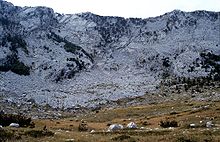Karst glacier
Karst glaciers are special forms of mountain glaciers that were first described in 1913 by the Serbian scholar Jovan Cvijić from the Dinarides . In the Austrian Limestone Alps , this term was used in particular for the Dachstein glaciers . The glacial traces in the Orjen also mostly belong to this type. The peculiarity of the glacial relief of the Orjens, Dachsteins, Durmitors and the Prokletije is always the relationship between glacial erosion and the primary karst relief. This prompted Jovan Cvijić to describe his own type of glacier, the karst glacier. These were typically developed on the Bijela gora plateau.
A characteristic is that in pronounced karst areas glaciers not only developed in karst relief, they also adapted to the karst structure. Here, plateau-like glaciers grow together from different karst hollow forms, which can become wide ice fields and then mostly develop short but very wide tongues.
A predominantly underground drainage is also characteristic. Jams and caves are still developing under the ice mass. As a result, if the meltwater has a continuous underground effect over the millennia, collapse dolines are created . Due to the moraine deposits of later glacier advances and retreats, these collapse dolines are more filled with moraine material than the immediate surrounding area. This protects you from further surface karstification.
Stratified stairs often form on the Kar walls, which create a furrowed picture with countless crevice , groove and gutter carts. The wide uvalas , which act as glacier feeding areas , are called Dolovi . They are wide, trough-shaped hollow shapes that can reach dimensions of up to 1 km.
The often sharp boundaries between barren karst and fertile moraine material are clearly visible in the landscape as the so-called “green-white boundary”. The characteristics of these fertile areas in the low and high mountains, such as low slope, water storage capacity, plant species richness, good accessibility and low karstification speak for good living conditions in the otherwise hostile karst landscape.
Karst glaciers left in their advance not only moraine hills but bare, especially in younger ice become steeper parts of rock that supplied by the glacial melt water can always be corroded. Short, parallel grooves, longer winding gullies on gently sloping plates, cart pits and crevices are signs of the loosening of the rock on the side walls of the glacier cirque. There are also round hump hollows which are still partly filled with snow in early summer and thus represent a constant water supply for karst corrosion .
The underground meltwater runoff, which is typical of karst glaciers, forms arches under the glaciers and thus causes moraine material to lie there in the longitudinal direction of the glacier river. After the glacier has melted back, a negative imprint of the glacier vault remains with the crowns of these longitudinal moraines.


